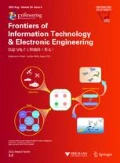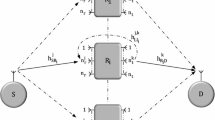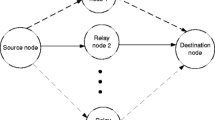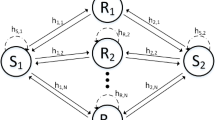Abstract
For multiple-relay cooperative networks with multiple antennas deployed at source and destination nodes, we investigate the outage performance of selection based semi-blind amplify-and-forward (AF) relaying, where transmit beamforming (TB) is conducted at source transmission and maximum ratio combining (MRC) at destination reception. Based on the Kolmogorov-Smirnov test, we analyze the impact of the configuration of destination antennas on the outage performance under arbitrary Nakagami-m fading channels. Results reveal that increasing the number of destination antennas is not necessary for an improvement of outage performance with any Nakagami-m parameter. Inspired by this fact, an approximation is proposed for the optimal selection. Simulation results show that the approximation is an efficient selection method.
Similar content being viewed by others
References
Behrouz, M., Hjørungnes, A., 2009a. Opportunistic Relaying for Space-Time Coded Cooperation with Multiple Antennas Terminals. Proc. IEEE Personal Indoor and Mobile Radio Communications Symp., p.1–5.
Behrouz, M., Hjørungnes, A., 2009b. Power allocation strategies for distributed space-time codes in amplify-and-forward mode. EURASIP J. Adv. Signal Process., 2009, Article No. 612719, p.1–13. [doi:10.1155/2009/612719]
Behrouz, M., Hjørungnes, A., Rajan, B.S., 2010. Quasi-Orthogonal Design and Performance Analysis of Amplify-and-Forward Relay Networks with Multiple-Antennas. Proc. IEEE Wireless Communications and Networking Conf., p.1–6.
da Costa, D.B., Aissa, S., 2009a. Cooperative dual-hop relaying systems with beamforming over Nakagami-m fading channels. IEEE Trans. Wirel. Commun., 8(8):3950–3954. [doi:10.1109/TWC.2009.081353]
da Costa, D.B., Aissa, S., 2009b. End-to-end performance of dual-hop semi-blind relaying systems with partial relay selection. IEEE Trans. Wirel. Commun., 8(8):4306–4315. [doi:10.1109/TWC.2009.081262]
Gradshteyn, I.S., Ryzhik, I.M., 2007. Table of Integrals, Series, and Products (7th Ed.). Academic Press, California, USA, p.340–341, 368.
Hasna, M.O., Alouini, M.S., 2004. A performance study of dual-hop transmissions with fixed gain relays. IEEE Trans. Wirel. Commun., 3(6):1963–1968. [doi:10.1109/TWC.2004.837470]
Krikidis, I., Thompson, J., McLaughlin, S., Goertz, N., 2008. Amplify-and-forward with partial relay selection. IEEE Commun. Lett., 12(4):235–237. [doi:10.1109/LCOMM.2008.071987]
Lehmann, E.L., Romano, J.P., 2008. Testing Statistical Hypotheses (Springer Texts in Statistics) (3rd Ed.). Springer, USA, p.584.
Lo, T.K.Y., 1999. Maximum ratio transmission. IEEE Trans. Commun., 47(10):1458–1461. [doi:10.1109/26.795811]
Muhaidat, S., Uysal, M., Adve, R., 2009. Blind Amplify-and-Forward Relaying in Multiple-Antenna Relay Networks. Proc. IEEE Wireless Communications and Networking Conf., p.1–6. [doi:10.1109/WCNC.2009.4917613]
Nosratinia, A., Hunter, T.E., Hedayat, A., 2004. Cooperative communication in wireless networks. IEEE Commun. Mag., 42(10):74–80. [doi:10.1109/MCOM.2004.1341264]
Sendonaris, A., Erkip, E., Aazhang, B., 2003a. User cooperation diversity-part I: system description. IEEE Trans. Commun., 51(11):1927–1938. [doi:10.1109/TCOMM.2003.818096]
Sendonaris, A., Erkip, E., Aazhang, B., 2003b. User cooperation diversity-part II: implementation aspects and performance analysis. IEEE Trans. Commun., 51(11):1939–1948. [doi:10.1109/TCOMM.2003.819238]
Suraweera, H.A., Michalopoulos, D.S., Karagiannidis, G.K., 2009. Semi-blind amplify-and-forward with partial relay selection. IET Electron. Lett., 45(6):317–319. [doi:10.1049/el.2009.3089]
Zhang, L., Chuai, G., Lin, L.F., Wen, X.J., 2008. Power allocation for cooperative decode-and-forward transmission with multiple cooperative relays and multiple received antennas. J. Beijing Univ. Posts Telecommun., 31(6):104–108 (in Chinese).
Author information
Authors and Affiliations
Corresponding author
Additional information
Project supported by the National Natural Science Foundation (No. 60772113), the National High-Tech Research and Development Program (863) (No. 2009AA011502), and the National Basic Research Program (973) of China (No. 2009CB320406)
Rights and permissions
About this article
Cite this article
Liu, Y., Zhang, Jh., Xu, W. et al. Statistical assessment of selection-based dual-hop semi-blind amplify-and-forward cooperative networks. J. Zhejiang Univ. - Sci. C 11, 785–792 (2010). https://doi.org/10.1631/jzus.C1010020
Received:
Accepted:
Published:
Issue Date:
DOI: https://doi.org/10.1631/jzus.C1010020




